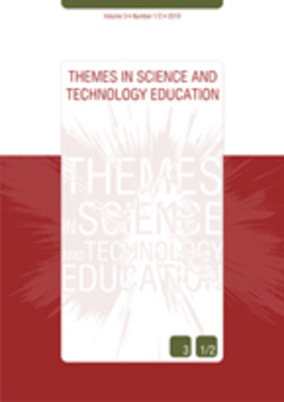Using control heuristics as a means to explore the educational potential of robotics kits
Part of : Themes in science and technology education ; Vol.6, No.1, 2013, pages 15-28
Issue:
Pages:
15-28
Author:
Abstract:
The educational potential of robotics kits as a form of control technology will remain undervalued until meaningful observation parameters are identified to enable a better understanding of children‟s control strategies. For this reason, this paper aims primarily to identify and classify the heuristics spontaneously applied by 6-10 year old children interacting with robotic devices containing specific transparency features (i.e. programmability) and interactivity features (i.e. immediacy of feedback). Two studies are described: an exploratory investigation into the control of a Lynx AL5A arm and a pilot study about the control of a Lego Mindstorms NXT®. Two issues relating to control heuristics are addressed: the heuristic shift and the perceived and objective level of task difficulty. The results demonstrate that three main types of heuristic emerge: (i) procedural-oriented, (ii) declarative-oriented, and (iii) metacognitive-oriented. Limitations of the difficulty indicators used and shift patterns proposed are discussed in relation to future research.
Subject:
Subject (LC):
Keywords:
educational robots, control heuristics, interactivity, transparency, Lego Mindstorms NXT®
Notes:
The research reported here was partially supported by the European 7th FWP - PRI-SCI-NET (http://www.prisci.net). Project Reference: 266647. The exploratory study was made possible by volunteers from the Planète Science Association, in particular Clement Quinson. The pilot study was made possible by a partnership with Carréfour Numérique (Cité des Sciences et de l‟lndustrie) http://www.universcience.fr/fr/carrefour-numerique who supported us by providing the assistance of a number of people who we would like to thank: David Forgereon, Isabelle Chabanon Pouget, Helena Ragot, Adrien Schwarz, Thierry Thibault, Lou Panier. Thanks to Carol-Ann Pinaud for her involvement in the data logging and retranscription.
References (1):
- Alimisis, D. (ed.) (2009). Teacher Education on Robotics-Enhanced Constructivist Pedagogical Methods. Athens: School of Pedagogical and Technological Education.Anderson, L.W., Krathwohl, D.R., Airasian, P.W., Cruikshank, K.A., Mayer, R.E., Pintrich, P.R., Raths, J., & Wittrock, M.C. (2001). A taxonomy for learning, teaching, and assessing: a revision of Bloom’s taxonomy of educational objectives. New York: Longman.Baecker, R. M., & Buxton, W.A.S. (1987). Readings in human-computer interaction : a multidisciplinary approach. San Mateo, CA: Kaufmann.Caci, B., Cardaci, M., & Lund, H.H. (2003). Assessing educational robotics by the robot edutainment questionnaire. Technical Reports 3. The Maersk McKinley Moeller Institute for Production Technologies, University of Southern Denmark.Carver, S. M., & Klahr, D. (1986). Assessing children„s LOGO debugging skills with a formal model. Journal of Educational Computing Research, 4, 487-525.Denis, B., & Baron, G.L. (Eds.) (1994). Regards sur la Robotique pédagogique. Actes du quatrième colloque sur la robotique pédagogique. Liège, 5-8 juillet. Paris: INRP.Gaudiello, I., Zibetti, E., & Pinaud, C-A. (2012). Control heuristics for educational robots: a pilot study. Proceedings of 3rd International Workshop Teaching Robotics, Teaching with Robotics. Integrating Robotics in School Curriculum (pp. 67-75). Trento, Italy: Riva del Garda.Gaudiello, I., & Zibetti, E. (in press). La robotique Educationnelle: Etat des lieux et Perspectives. Psychologie Française. Retrieved 12 March 2013, from http://dx.doi.org/10.1016/j.psfr.2012.09.006. Harrison, A. G., & Treagust, D. F. (2001). Conceptual change using multiple interpretive perspectives: Two case studies in secondary school chemistry. Instructional Science, 29, 45-85.Highfield, K., Mulligan, J., & Hedberg, J. (2008). Early mathematics learning through exploration with programmable toys. Proceedings of the Joint Meeting of PME 32 and PME-NA (pp. 169-176). Mexico: International Group for the Psychology of Mathematics.Kennewell, S., Tanner, H., Jones, S., & Beauchamp, G. (2008). Analysing the use of interactive technology to implement interactive teaching. Journal of Computer Assisted Learning, 24(1), 61–73.Kynigos, C. (2008). Black-and-white-box perspectives to distributed control and constructionism in learning with robotics. Workshop Proceedings of International Conference on Simulation Modeling and Programming for Autonomous Robots (SIMPAR) (pp. 41-49). Venice, Italy.Levy, S., & Mioduser, D. (2008). Does it „„want‟‟ or „„was it programmed to…‟‟? Kindergarten children‟s explanations of an autonomous robot‟s adaptive functioning. International Journal of Technology and Design Education, 18(4), 337–359.Newell, A., & Simon, H.A. (1972). Human problem solving. NJ: Englewood Cliffs Prentice.Papert, S., & Harel, I., (eds.) (1991). Constructionism. NJ: Ablex Publishing Corporation.Pea, R.D., & Kurland, D. (1984). On the cognitive effect of learning computer program. New Ideas in Psychology, 2(2), 137-168.Piaget, J. (1972). The principles of genetic epistemology. London: Routledge & Kegan Paul. Rada, R., & Michailidis, A. (1995). Interactive media. New York: Springer-Verlag.Resnick, M., Martin, F., Sargent, R., & Silverman, B. (1996). Programmable bricks: Toys to think with. IBM Systems Journal, 35(3-4), 443-452.Ribeiro C., Coutinho, C., & Costa, M.F. (2011). Proposal for the evaluation of educational robotics in basic schools. Proceedings of International Study Association on Teachers and Teaching (ISATT) (pp. 831-839). Rose, E. (1999). Deconstructing interactivity in educational computing. Educational Technology, 39(1), 43-49.Sfard, A. (1991). On the dual nature of mathematical conception: reflection on processes and objects as different sides of the same coin. Educational Studies in Mathematics, 22, 1-36.Sullivan, F. V. (2008). Robotics and science literacy: Thinking skills, science process skills and systems understanding. Journal of Research in Science Teaching, 45(3), 373-394.Svanæs, D. (2000). Understanding Interactivity: Steps to a Phenomenology of Human-Computer Interaction. Unpublished PhD thesis. NTNU, Norway, Retrieved 5 November 2012, http://tinyurl.com/und-int.Yacci, M. (2000). Interactivity Demystified: A Structural Definition for Distance Education and Intelligent CBT. Educational Technology, 40(4), 5-16.Zuga, K. (2004). Improving technology education research on cognition. International Journal of Technology and Design Education, 14, 79-87.




